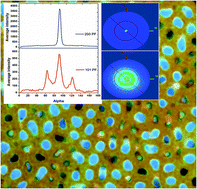Electrodeposition of tin nanowires from a dichloromethane based electrolyte†
Abstract
Tin was electrodeposited from a dichloromethane-based electrolyte at ambient temperature into gold coated anodic alumina membranes with nanoscale pores. The tin nanowires are mainly 〈200〉 aligned, together with some 〈101〉 and 〈301〉 wires. Partial filling of the structure and a distribution of wire lengths was found. Grafting of the pores with hydrophobic surface groups was trialled as a means of modifying the deposition, however, it did not increase the proportion of pores in which wires grew. Under potentiostatic conditions the limited rates of nucleation and diffusion down the 1D pores control the growth of the nanowires.



 Please wait while we load your content...
Please wait while we load your content...